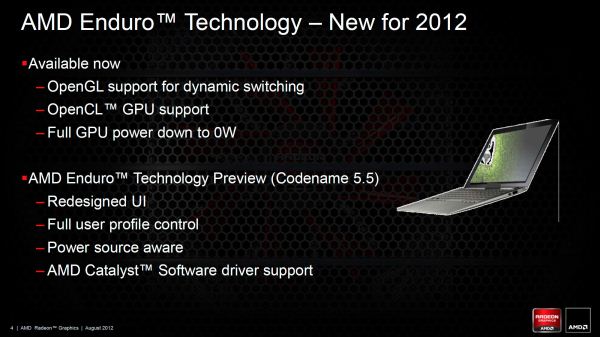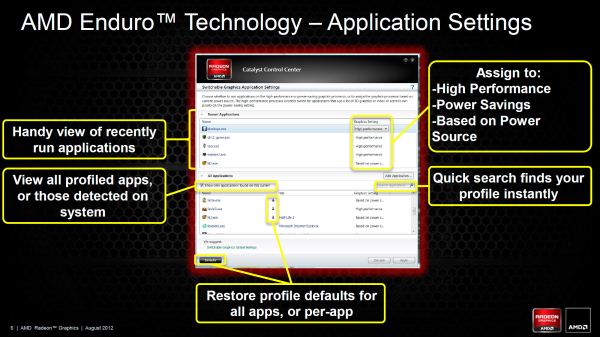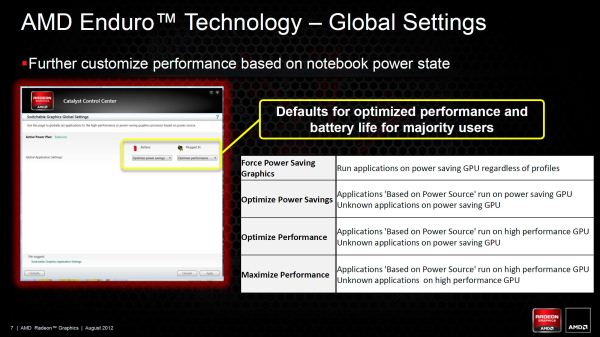AMD’s Enduro Switchable Graphics Levels Up
by Jarred Walton on September 6, 2012 3:00 AM ESTNew for Mid-2012: “Enduro 5.5” Enhancements
When AMD created the Enduro brand, they were really almost where we wanted them. They had dynamic switching with support for most of the latest games and applications, and when it worked properly it would be difficult to tell if you were using an NVIDIA or an AMD dGPU. The problem was when things didn’t work and you had to go into the drivers, and there were several problems. OpenGL support was totally out, many of the latest games were also missing default profiles (and sometimes wouldn’t let you properly specify the correct GPU), the UI was obtrusive and sometimes hard to use (particularly for power users), and the drivers were dictated by the laptop manufacturers and were usually months old at launch and never updated.
While the UI seems like a minor thing to fix—I would have thought one or two months to improve the UI would have been sufficient—at least prior to the forthcoming update it remained largely unchanged. The lack of AMD-provided driver updates was really the major issue, because everything else could potentially be fixed with new drivers and you would never know. The other areas like OpenGL/OpenCL and support for various games/applications should improve over time as well, provided you can get drivers. That brings us to the upcoming Enduro release, scheduled to come out sometime this month or next. Officially it’s still just Enduro, but to help differentiate between the previous Enduro release and the upcoming release we’ll sometimes refer to the new version as “Enduro 5.5”.
The biggest news with the latest iteration of Enduro is that AMD is planning to make universal reference drivers available for all the Enduro laptops. It’s not clear precisely what that means, but potentially any laptop with Dynamic Switchable Graphics or later (e.g. PX4.0 and later) would be supported by AMD’s “reference” drivers. That’s huge, and if AMD can deliver it will assuage most of our concerns with their hardware/software. Hopefully none of the OEMs get bent out of shape or refuse to allow support, which is a problem we've seen in the past. We should see the first public release in the next month or two, and then another release somewhere in the November/December timeframe.
Besides the availability of driver updates, the UI also receives a much needed overhaul, providing both regular and power users all the options they’re likely to need as far as control of graphics switching is concerned. Open up the switchable graphics options and the top section remains largely the same, but the bottom now allows you to see all application profiles (or just the profiles for detected applications). There’s also a quick search option that works both on executable name and application/game name (e.g. HL2.exe or Half-Life 2 will both find the profile for Half-Life 2). From either list (recently used apps up top, or all apps at the bottom), you can set the GPU profile.
Where previously there were two settings (three if you count “Not Assigned”), there are now three options. As before, “Power saving” sets an application to run on the integrated graphics while “High performance” sets an application to run on the discrete GPU. The new third option is “Based on power source”, which does precisely what you’d expect: plug the laptop in and the apps with this setting will run on the discrete GPU; switch to battery power and they’ll run on the integrated graphics. For many users, everything could default to “Based on power source” and they would be happy, but certainly there will be times where you’re running on battery power but still want to use the dGPU and the drivers give you that option. Should things get squirrelly, you can also reset applications individually or globally to their default settings. It’s worth noting that the power state aware setting is something that NVIDIA currently does not implement, requiring manual intervention if you wish to override your normal settings—though how often people are using apps that require the dGPU while on battery power is something we could debate.
Besides the individual application profiles, AMD is also adding a new area to their drivers: Switchable Graphics Global Settings. This is something you could sort of get before with some laptops, but previously it involved changing from Dynamic Switchable Graphics to manual switching (i.e. switching based on power source) and then forcing the laptop into High Performance or Power Saving mode if you wanted to be low power while plugged in or high power while unplugged. That was clunky and at least in the case of the Sony VAIO C we tested it caused flickering similar to the old switchable graphics, with the dGPU drivers getting unloaded and iGPU drivers getting loaded (or vice versa), with some work behind the scenes copying context from one GPU to the other. It worked but it wasn’t elegant; perhaps more importantly, Microsoft doesn’t want anyone doing this with Windows 8 and thus new laptops won’t be able to get a Windows 8 sticker if they use this method of switching (which basically means no new laptops will do this). To make up for the loss of this functionality (which some people still prefer), AMD has added a new global settings section.
Unlike the individual application profiles, the global settings gives you four options each for Battery and Plugged In. The top two options are similar in most cases and will generally run most applications on the iGPU, and the same goes for the bottom two modes where you’ll run most apps on the dGPU. The difference is that “Force Power Saving GPU” will run all applications (regardless of what the custom profile says) on the iGPU, essentially disabling the dGPU completely. “Optimize Power Savings” in contrast will run all unknown or “Based on power source” applications on the iGPU while respecting the application profiles where they exist. “Optimize Performance” is sort of the reverse of that, running all “Based on power source” applications on the dGPU while leaving unknown applications on the iGPU. Finally, the “Maximize Performance” option runs all unknown and “Based on power source” applications on the dGPU—but applications specifically set to use the iGPU will continue to do so.
The reason for that last discrepancy (e.g. why you can’t simply run everything on the dGPU and forget about the iGPU) is that certain tools have to run on the iGPU. Intel’s drivers are one example—loading those up on the dGPU would cause problems. Intel’s WiDi is the only other I could find on my particular Clevo notebook. We were told that some of the laptop utilities like an overlay showing percentage of brightness, volume, etc. may also need to run on the iGPU. Besides the few applications that have to run on the iGPU, any applications that are set to Power Saving will continue to use the iGPU—and this makes sense as there are a lot of applications that can be set to run on iGPU/dGPU that have no need of higher performance GPU options (several anti-virus utilities come to mind, where they're starting to create a 3D context for their UI). The net result is that other than a few specific applications where the profile will exist and be locked to the iGPU, with no option to change to dGPU, everything else that uses higher function graphics can be customized to run on a specific GPU, but if you set something to iGPU presumably you want it to always run there—otherwise you would use the “Based on power source” setting.
A full set of screenshots from all the driver screens is available in the gallery below if you’re interested.
One final topic worth discussing is Windows 8. Certainly there are owners of existing laptops with switchable graphics that are wondering if they can upgrade to Windows 8 and what will happen. We’ll have to see how this actually plays out, but it sounds like the earlier versions of PowerXpress (3.0 and earlier) will probably get support with one driver bundled with Windows 8, and that may be it—but there’s always the possibility for the laptop OEMs to release their own updates, or for AMD to roll out additional drivers for older laptops. The potential for PowerXpress 4.0 and later laptops to get regular driver updates (for Windows Vista/7/8) is there, but until we actually start seeing public driver releases AMD hasn’t fully committed to supporting all of those laptops.



















200 Comments
View All Comments
Ryan Smith - Thursday, September 6, 2012 - link
Your comment will not be deleted. We do not delete comments except for spam.prophet001 - Thursday, September 6, 2012 - link
This isn't Clevo's support thread :/Seanzky - Thursday, September 6, 2012 - link
Thank goodness, because we want AMD to hear about their Enduro issues. Not Clevo.hulawafu77 - Thursday, September 6, 2012 - link
Amen to that. Clevo is not at fault for this. This is about AMD's complete lack of driver support for mobile GCN. I hope others reading get that through their head, this is not an OEM issue, this is completely AMD's 100% fault here.arcticjoe - Thursday, September 6, 2012 - link
this issue affects virtually all 7000 series laptop cards that use muxless design. Naturally this bottleneck is the most visible on 7970m because its the fastest card, so most vocal users will be 7970m users.sirizak - Thursday, September 6, 2012 - link
The only laptop that gets around this is the Alienware, as it has a hardware switch to force the dedicated graphics instead of the faulty implementation Clevo and AMD are serving up here.I'm just glad to see this sugject finally getting dragged to the surface here, Hopefully this might motivate AMD to come to the party with quick solution.
It would be a shame to see a great product like the 7970m goto the junk pile because of their lack of support.
JarredWalton - Thursday, September 6, 2012 - link
There are no "quick fix" solutions for complex problems. As for the Alienware, the interesting thing is that it has hardware muxes so you can turn off the integrated graphics (so the display outputs get routed directly to the dGPU). Why would they do that when they have Enduro? Probably because they don't like the way Enduro works right now but they wanted to give users the option of getting better battery life. How's that for confidence?hulawafu77 - Thursday, September 6, 2012 - link
Yep, just go to NBR or Guru3D. There are HP owners who are suffering from this and Lenovo and Dell that aren't AW. Anyone using Enduro is affected if they can't disable it in the BIOS.Pixelpusher6 - Thursday, September 6, 2012 - link
Wow I didn't realize there were so many problems with AMD's Enduro solution. I knew that Nvidia's Optimus solution was far superior but I didn't know about all the problems with Enduro for 7970m users. Once again I think this shows very questionable management at AMD. I have been saying for the last 6 months that AMD has been making very poor management decisions and this is another one of those. Instead of trying to sweep it under the rug the AMD support staff should be working with users to pinpoint the problem. I'm sure it is something that can be fixed with some new drivers, unless AMD knows something we don't and that is why they are trying to bury it.Seanzky - Thursday, September 6, 2012 - link
Before anyone brands me as "AMD-hating" please know that this is purely speculation on my part. AMD, being relatively smaller compared to nVidia, can only focus so much of their resources by looking into this issue. They can't be a step behind in the race for the next gen GPU. So the question is: will they split their resources to support their paying customers (me among many) or will they just sweep this under the rug and focus all their manpower to fix Enduro in the next series?AMD is lucky that I am willing to chuck this up as an expensive lesson learned. I am most likely not going to be buying AMD in the near future as I do have enough funds for upgrading my laptop. The same can't be said for other 7970M owners, though. There are many tight-budgeted college students who bought into AMD's flagship card.